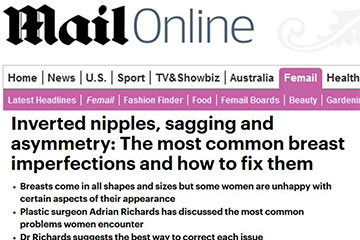
The most common breast imperfections and how to fix them
PLASTIC AND COSMETIC SURGERY
The Daily Mail
Inverted nipples, sagging and asymmetry: The most common breast imperfections and how to fix them.
- Breasts come in all shapes and sizes but some women are unhappy with certain aspects of their appearance
- Plastic surgeon Adrian Richards has discussed the most common problems women encounter
- Dr Richards suggests the best way to correct each issue
From a young age, we’re taught that breasts come in all shapes and sizes and that when it comes to boobs, the notion of normal doesn’t necessarily exist.
However for some of us, certain things we see as imperfections have left us concerned, embarrassed and unwilling to expose ourselves even to those closest to us.
Here Mr Adrian Richards, Consultant Plastic Surgeon at The Private Clinic of Harley Street, discusses some of the most common concerns women have about their breasts – and how to solve them.
INVERTED NIPPLES
What is it?
Nipple inversion is caused by an imbalance between the inward traction of the milk ducts and the traction of the muscle within the nipple, which essentially pulls the nipple outwards.
If the inward force is greater than the force exerted by the muscle within the nipple, inverted nipples will result.
[…]
Is there a solution?
Firstly, it’s worth checking with your GP to make sure that everything is as it should be. If nipple inversion occurs later in life, it could be a sign of underlying breast pathology or possibly even cancer, so it’s best to check with your doctor to rule out any underlying medical conditions.
SAGGING BREASTS
What is it?
There are two main causes of sagging breasts, also known as breast ptosis: weight loss and childbirth/breastfeeding. In both cases, breasts lose a significant amount of volume, particularly in the upper part of the breast, and the nipples will also lie at a lower position.
[…]
Is there a solution?
Breast uplift surgery, also known as a mastopexy, is similar to a breast reduction in that it works by lifting the nipples and tightening the skin. This procedure – in comparison to a breast reduction where breast tissue is removed – only removes skin, and the breast tissue is preserved and reshaped.
[…]
ENLARGED AREOLAS
What is it?
The areola is the brown/pink area around the nipple. The average diameter of a normal areola is 4-4.5cm, and medical studies have shown that the ideal diameter of the areola should be in the region of 4.7cm (for an average height woman).
[…]
Is there a solution?
Areola reduction surgery can help with either the size or shape of your areolas. The procedure is relatively quick, performed under general or local anaesthetic, and can be performed on both men and women.
[…]
OVERSIZED BREASTS
What is it?
Large breasts can cause women a number of difficulties, including back pain, neck pain, postural problems, exercise difficulty, difficulty in finding clothes that fit and recurrent infections in the fold under the breasts such as impetigo.
[…]
Is there a solution?
Breast reduction, or mammoplasty, is a surgical procedure which can reduce the size of the breasts. It reshapes and reduces large, heavy breasts, improving their appearance and with it reducing back pain and improving posture.
[…]
OVERSIZED NIPPLES
What is it?
Enlarged protuberant nipples can cause embarrassment for both women and men. Typically, those who suffer with oversized nipples avoid wearing tight clothing
[…]
Is there a solution?
A nipple reduction procedure, which can correct overly prominent, wide or puffy nipples, is an option for some women. The procedure is relatively straightforward, performed under local anaesthetic and takes around 20 minutes per nipple.
[…]
TUBEROUS BREASTS
What is it?
Tuberous breasts (also known as tubular or constricted breasts) are an abnormality in the breast shape. Few people realise that this condition is in fact genetic and is characterised by a tightened, narrow base to your breast and a high crease, causing the breasts to look elongated.
[…]
Is there a solution?
The potential treatment options for patients with tubular breasts varies from person to person. For women who have some constriction at the base, but where the nipples are in a relatively normal position, often a breast implant alone is enough to offer a correction
[…]
ASYMMETRICAL BREASTS
What is it?
In reality, no female has entirely symmetrical breasts. Every woman has one breast which is slightly larger or a slightly different shape than the other. For some women, that asymmetry is almost impossible to spot. For others, it’s far easier to spot.
[…]
Is there a solution?
As with the treatment of tuberous breasts, there is no ‘one size fits all’ approach to correcting asymmetrical breasts. It may be that a combination of surgical – such as implants or breast reduction – or non-surgical procedures could offer a solution, but that will very much change on a case by case basis.





